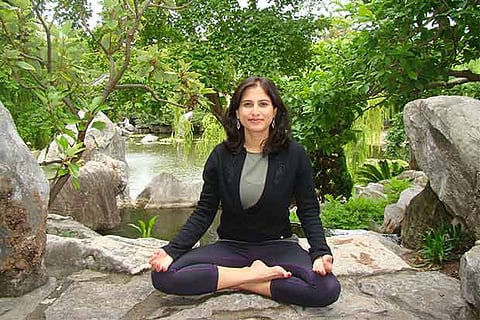

Chennai
In Patanjali’s yoga sutras the eight-fold path is called ash tanga, which literally means eight limbs or branches, of which asana or physical yoga posture is merely one branch; breath or pranayama is another.
The first two limbs — yamas and niyamas (moral codes or ‘dos and don’ts) — are given special emphasis to be practiced in conjunction with the third and fourth limbs (asana and pranayama). If there were no moral codes, then traditional yoga would be nothing more than an exercise program.
The fifth is pratyahara or withdrawal of the senses, sixth is dharana or focused concentration, seventh is dhyana or meditative absorption and the last one is samadhi or bliss. These eight steps basically act as guidelines on how to live a meaningful and purposeful life. They serve as a prescription for moral, ethical conduct and self-discipline. They direct attention toward one’s health; and they help us to acknowledge the spiritual aspects of our nature.
The first limb, yama deals with one’s ethical standards and sense of integrity, focusing on our behaviour and how we conduct ourselves in life. Yamas are universal practices that relate best to what we know as the golden rule, ‘Do unto others as you would have them do unto you.’
The yoga sutra is not presented in an attempt to control behaviour based on moral imperatives. The sutras don’t imply that we are ‘bad’ or ‘good’ based upon our behaviour, but rather that if we choose certain behaviour we get certain results.In many ways, the yamas and niyamas overlap with the ten commandments. There are five yamas — ahimsa (nonviolence); satya (truthfulness); asteya (nonstealing); brahmacharya (continence) and aparigraha: (noncovetousness) The first of the yamas is probably the most famous, ahimsa. This refers not only to physical violence, but also to the violence of words or thoughts.
Most people think that if they are vegetarian they are practicing ahimsa. It’s more than that, its entire abstinence from causing any pain or harm whatsoever to any living creature, either by thought, word or deed. To practice ahimsa is to be constantly vigilant, to observe ourselves in interaction with others and to notice our thoughts and intentions.
Try practicing ahimsa by observing your thoughts when a smoker sits next to you. Your thoughts may be just as damaging to your health as his cigarette is to him. Protecting ourselves and others does not violate ahimsa. Practicing ahimsa means we take responsibility for our own harmful behaviour and attempt to stop the harm caused by others. Being neutral is not the point.
The writer is a certified international yoga acharya and owner of Old Mercara, a brand of homemade ice creams, honey, jams and squashes.
Visit news.dtnext.in to explore our interactive epaper!
Download the DT Next app for more exciting features!
Click here for iOS
Click here for Android